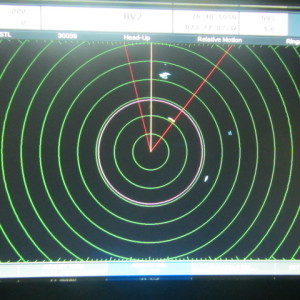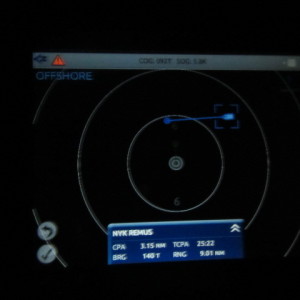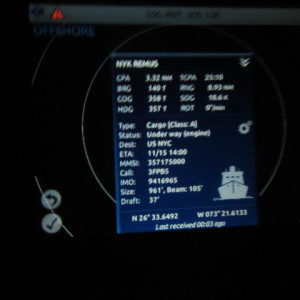Don’t Want to Become a Ship’s Pancake (Thursday, November 12th)
Well, it is 1:45 a.m. as I write this, and I am keeping my eye on a ship that is on my starboard side about 13 miles out on the radar at this point. I need to make sure he doesn’t have “constant bearing/decreasing range.” If this is a new term for you like is was for me prior to a few years ago, it means basically that if the ship doesn’t move relative to your boat’s position as it gets closer, then you have to worry about possible collision. If you see that the boat, over time, is moving on a different course relative to your boat, then you won’t collide. There are a few ways to figure this out. We have radar, and the photo below shows that you can set a ring and a line to show where the vessel is for that radar transmission.
On the next transmission, you hope to see that he isn’t closer (circle) at the same position relative to your course (line). (You can also use a feature called “MARPA” on your radar, but given that the little red button on our Raymarine radar stopped working on about night 4 of sailing, we no longer have that capability until we get a replacement panel—once again…and this is also why we are limited to radar transmissions every 3 minutes rather than continuously, too…)
Another way to assess constant bearing/decreasing range is by sight, but I feel better using this method during the day when you can actually see. Ship lights can be confusing, and their distance can be difficult to discern. But, during the day, you can pick a spot on your vessel to determine the ship’s relative position to your boat, wait a few minutes, and see if the ship is in the same relative position. Then you just hope that it is not—because that is definitely easiest.
We also have AIS, which is GREAT! If it is a commercial vessel you’re dealing with, it should be broadcasting via AIS its name, size, where it is going, its current course, and its speed over ground. Then it will tell you at what point you will be closest to this ship, and what that distance will be. We did have a Class A ship that did not broadcast via AIS so you cannot rely on this method of spotting ships exclusively.
Okay, from AIS, I just learned that the vessel I am watching is NYK Remus and it is headed for New York City.
It is 961 feet long, over a hundred feet wide, and should be at our closest point of approach of about 3 miles in 25 minutes. Personally, I would rather a little more distance at night (what if he changes course at the last minute??) so I am going to do a few things to guarantee he won’t come too close to us. Right now, we are under power and not sail, because there is essentially no wind and what little there is happens to be right on our bow. So this is easy-peasy. I am going to slow down and adjust course seven degrees south (which is to the right because I am heading due east at about 90-91 degrees True). This will give me a more distant “closest point of approach” (CPA) which will make this ‘ole gal a little more comfortable. Why seven degrees? I don’t know. It seems like enough, but is fairly arbitrary. Lucky number seven at the craps table, maybe?
So what do you do if your sails are up? I am sure there is more than one answer to this question, but I would have kept my course and lived with a 3 mile CPA if I had to tack the boat. Given current conditions, if it were within 3 miles and my sails were up, I would have “fallen off.” The wind is slightly to port, so we would have been on a port tack had the sails been up (jib would have been on the starboard side), so I would have turned my 7 degrees south. I wouldn’t have bothered to trim the sails accordingly (which would have been to let them out just a little bit), because I would not want to increase the speed of my vessel. I am sure there are other ways to handle the situation, but this is how I would do it, given what I know up to this point. I am definitely learning as I go…
I took a “six pack” captain’s course in April and I learned about all of the light configurations you can see on ships at night and what those mean. So, on our buddy RMK Remus who is on our starboard side, I saw a white light on the left, a red light in the middle, and two white lights on the right. Looking through binoculars, I knew that I was seeing ‘ole Remus’s port side since I could see a red running light and I could tell bow from stern given the height of the white lights. That meant he was headed north, across my bow. Knowing about the lights helps, but really, at the end of the day, the only thing you have to know is: don’t hit anything with lights.
All that writing has taken some time. Mr. Remus has now crossed our bow and is off and running to the big city where it will be cold this time of year…
That was all a lot like school, wasn’t it? So let’s lighten this up with a funny tidbit before I close this out. At 4 in the morning yesterday, I relieved Dan from his watch. We try not to put on a whole lot of lights because it kills your night vision. He went down to our head to brush his teeth, and he came up afterward and said: “I thought I stepped on a tube of Benadryl on the floor, but I turned on the light and it was a fish!” One of the flying fish decided to do a Kamikaze mission! He had to jump up more than six feet out of the water, clear our safety lines, and time it perfectly so that he fell into our bathroom’s ceiling window…too bad he wasn’t a yellow fin tuna…yum.


